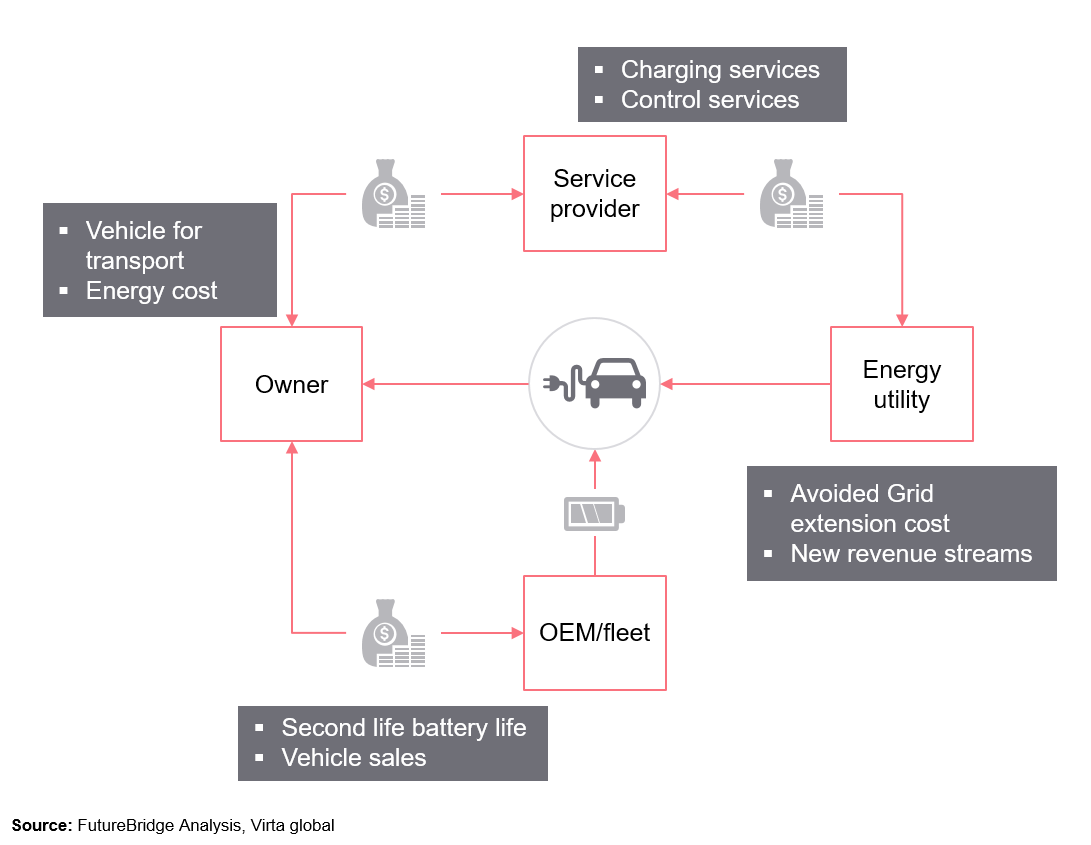Introduction
Decarbonization, energy efficiency, and electrification are the key pathways to tackle the climate crisis. The energy and mobility sectors will converge in the future to effectively contribute to tackling climate change. The last decade has witnessed one such convergence i.e., uptake of electric vehicles (EV) and development of electric vehicles charging infrastructure.
Initially, with low penetration, EVs were considered the same as other electrical loads. As the market for EVs grows across major global economies, various possibilities of connecting EVs with grids are being investigated. The global sale of EVs is projected to reach 26 million in 2030, with a 28% share of electric passenger cars. At any given time, over 90% of the electric vehicles remain parked, which is a lot of energy sitting idle i.e., EVs are the movable energy storage assets. Amidst various technological advancements like smart charging infrastructure and demand-side response, EVs bring opportunities for each stakeholder i.e., Utilities, Network operators, EV owners, OEMs, and aggregators. Vehicle-to-grid (V2G) technology is one such enabling mechanism to extract benefits for the stakeholders.
V2G technology
V2G technology is a bidirectional EV charging. It enables the energy stored in electric vehicles to be fed back into the electricity network (or grid) during peak demand or as backup power for the EV owner during a power cut. EV charging technology has evolved from an unmanaged to smart charging level in the last decade. V2G technology can play an important role in balancing the national electricity network by providing a demand-side response (DSR) facility with the installation of smart meters, i.e., to rebalance the country’s energy needs by changing how energy is produced, supplied and used. V2G is capable of performing varied DSR activities such as peak clipping, valley filling, and load shifting. The adoption of V2G technology will enable increased onsite generation from renewable resources and storage for later use.
Smart charging is the intelligent charging of electric cars. It’s a program through which energy suppliers incentivize EV owners to curtail charging when energy demand is particularly high and feed the electricity back during peak demand.
V2G technology and devices
To fully benefit from the opportunities associated with V2G technology, the availability and maturity of V2G technology in the market is a prerequisite. V2G charging devices are essentially DC chargers, and various EV charging infrastructure providers have developed device models that are compatible with V2G technology. So V2G enabled devices exist and are feasible, yet there is room for improvement as the technology matures.
Examples of V2G charger manufacturers:

What value proposition V2G can offer?
With the increasing electrification of automobiles, the V2G technology serves as the enabler to use EV batteries as short-term storage and immediate supply.
- For the EV owners, adoption of V2G technology along with solar panels can convert the home into a private mini-power station and simultaneously generating a constant revenue
- Fleet operators/ OEMs can benefit by adopting different target groups (EV owners, Shared mobility providers, or Businesses leasing EVs) based business models to add value such as payments for providing battery capacity. The OEMs can opt for second-life battery projects using EV batteries
- For the power grid, the adoption of V2G technology will save higher infrastructure costs involved in large-scale stationary storage infrastructure and from maintaining a reserve capacity for peak demand at higher electricity prices.

Recent Developments
- Nissan has signed a cooperation agreement with EDF Group focused on the development of V2G and smart
 charging solutions, where Nissan will be responsible for the sale of V2G compatible EVs, and EDF Group will provide V2G charging infrastructure. The companies are betting on the partnership to open new revenue opportunities for providing energy management capabilities to businesses using Nissan LEAF and e-NV200 through V2G solution.
charging solutions, where Nissan will be responsible for the sale of V2G compatible EVs, and EDF Group will provide V2G charging infrastructure. The companies are betting on the partnership to open new revenue opportunities for providing energy management capabilities to businesses using Nissan LEAF and e-NV200 through V2G solution.  A project – E-Flex, led by a consortium including Cisco, Cenex, Nuvve, and Imperial College London is currently exploring the commercial feasibility of V2G technology in London and Plymouth.
A project – E-Flex, led by a consortium including Cisco, Cenex, Nuvve, and Imperial College London is currently exploring the commercial feasibility of V2G technology in London and Plymouth. Dominion Energy, a utility in Virginia, US, has developed a plan to use batteries within electric school buses as a grid flexibility asset. The first 50 electric buses are expected to be operational by the end of 2020.
Dominion Energy, a utility in Virginia, US, has developed a plan to use batteries within electric school buses as a grid flexibility asset. The first 50 electric buses are expected to be operational by the end of 2020.
Challenges
Regardless of the potential revenue streams and several national and regional schemes to incentivize EVs, the mass adoption of EVs, and therefore V2G is yet to be witnessed. Some of the current challenges the technology is facing include:
- Policy and regulation maturity – energy markets exclude EVs participation in the provision of balancing services.
- EV manufacturers do not provide battery leasing options that allow owners to enter into V2G market without nullifying the warranties
- A lack of V2G charger manufacturers on the market and V2G enabled EV manufacturers.
- The cybersecurity risk – EVs being connected to smart grids brings data security challenges
V2G is certainly an important opportunity for the stakeholders and V2G will become a vital solution at locations where the energy system is most volatile. It is necessary to ensure that bidirectional charging infrastructure and V2G enabled EVs are available in the market for the complete realization of V2G technology’s benefits.




 5 min read
5 min read
































